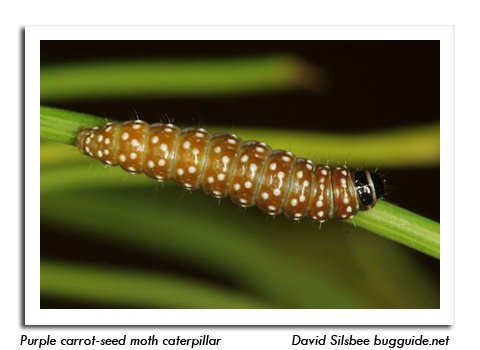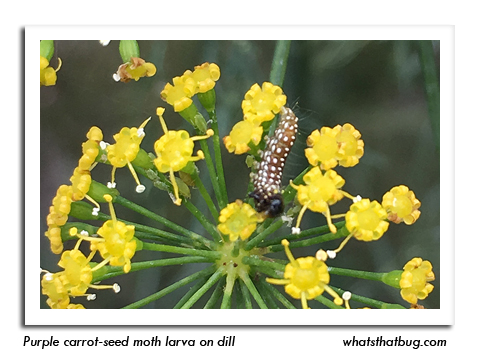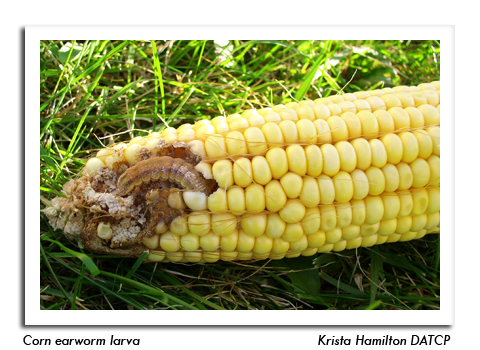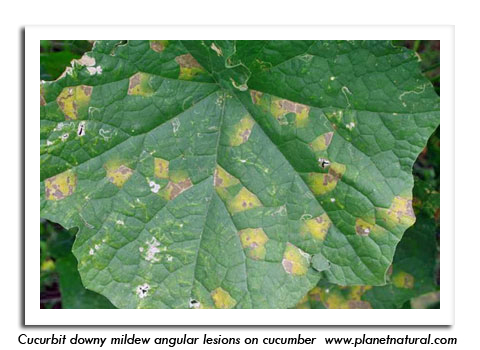
 |
|
|
Vegetables
Volume 63 Number 17 Date 08/30/2018 NEW STATE RECORD - The UW-Madison Insect Diagnostic Lab has confirmed the first detection in Wisconsin of the purple carrot-seed moth (Depressaria depressana), a non-native European pest of carrots, dill, and related plants. Several larvae have been observed on the umbels of dill plants, as well as on cilantro and Queen Anne's lace, since mid-July. The first specimens, from the Village of Luxemburg in Kewaunee County, were identified by PJ Leisch on July 10. Additional reports have subsequently come in from Brown, Columbia, Dodge, Milwaukee, Sheboygan and Washington counties. First documented in North America roughly a decade ago, the purple carrot-seed moth is now occurs in parts of the northeastern U.S. and Canada, and has recently been found in Illinois, Indiana, and Ohio. The small (~1 cm) caterpillars are either dark green or reddish-purple with rows of distinct white spots. Adult moths have a wingspan of ~1 cm and are grey with a pale patch near the head. The greatest impact expected from this insect would be to plants in the carrot family specifically grown for seed, such as coriander, dill, and fennel. According to Wisconsin reports, some of the dill umbels were infested with 2-3 dozen or more caterpillars. LATE BLIGHT - Potato and tomato growers are encouraged to continue protective fungicide treatments and monitoring plants for signs of infection. Development of this disease has been confirmed by the UW on potato in three counties (Adams, Marquette, and Waushara), though late blight could become more widespread given recent cool, wet weather conditions. Removal and destruction of infected plants is required if lesions are noticed. Composting will not generate sufficient heat to kill the pathogen and is not recommended. SQUASH BUG - Egg deposition is still occurring in home gardens and larger plantings. Several fresh egg masses and many small nymphs were found this week on acorn squash in La Crosse County, emphasizing the need for thorough fall clean-up of garden debris to reduce populations and eliminate winter hibernation sites. Crop rotation is also suggested if squash bugs have been a problem this summer. BASIL DOWNY MILDEW - The state's first basil downy mildew (BDM) case of the 2018 season was confirmed in Rock County in the past week. Basil samples with BDM symptoms, including yellow angular lesions between the leaf veins, and dark gray or purplish sporulation on leaf undersides, can be submitted for testing to the UW Plant Disease Diagnostics Clinic, 1630 Linden Drive, Madison, WI 53706-1598. Information on how to properly send samples is available at https://pddc.wisc.edu/sample-collection-and-submission/. CORN EARWORM - Moths appeared in very high numbers in pheromone trap collections for the third consecutive week. Counts at the Dodge and Fond du Lac County monitoring sites were particularly high and ranged from 830-1,093 moths per trap. The latest activity signals that the threat to late sweet corn plantings has intensified. Pheromone trap counts for the August 23-30 reporting period were as follows: Arlington 193, Beaver Dam 1,093, Cottage Grove 98, Hancock 16, Janesville 40, Madison north 72, Marshfield 1, Mayville 830, Pardeeville 32, Ripon 514, Sun Prairie 220 and Watertown 248. CUCURBIT DOWNY MILDEW - New reports were common in the past week, with detections in Dane, Ozaukee, and Portage counties. The first cucurbit downy mildew (CDM) case of the season was identified on August 17 in Columbia County. UW Vegetable Pathologist Dr. Amanda Gevens recommends a five-day preventive fungicide spray interval for cucumbers now that CDM inoculum has arrived in the state. A seven to 10-day interval is appropriate for cantaloupe, gourd, melon, pumpkin, squash and zucchini. Fungicide options are listed in UW-Extension publication A3978: http://learningstore.uwex.edu/Assets/pdfs/A3978.pdf. Cucurbit downy mildew is best managed before symptoms develop. -- Krista Hamilton, DATCP Entomologist 





|
|
|